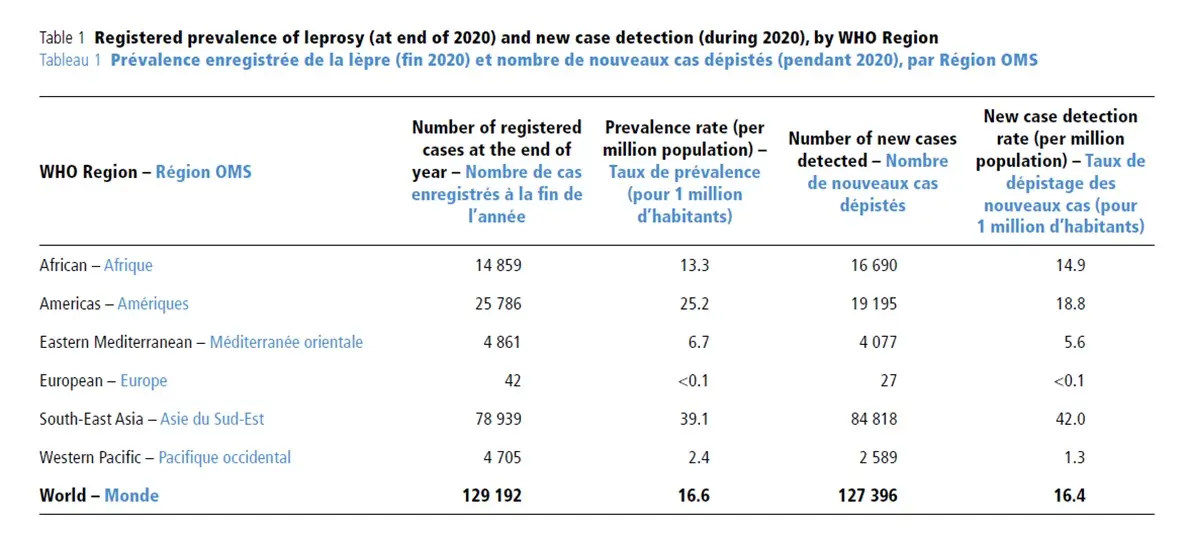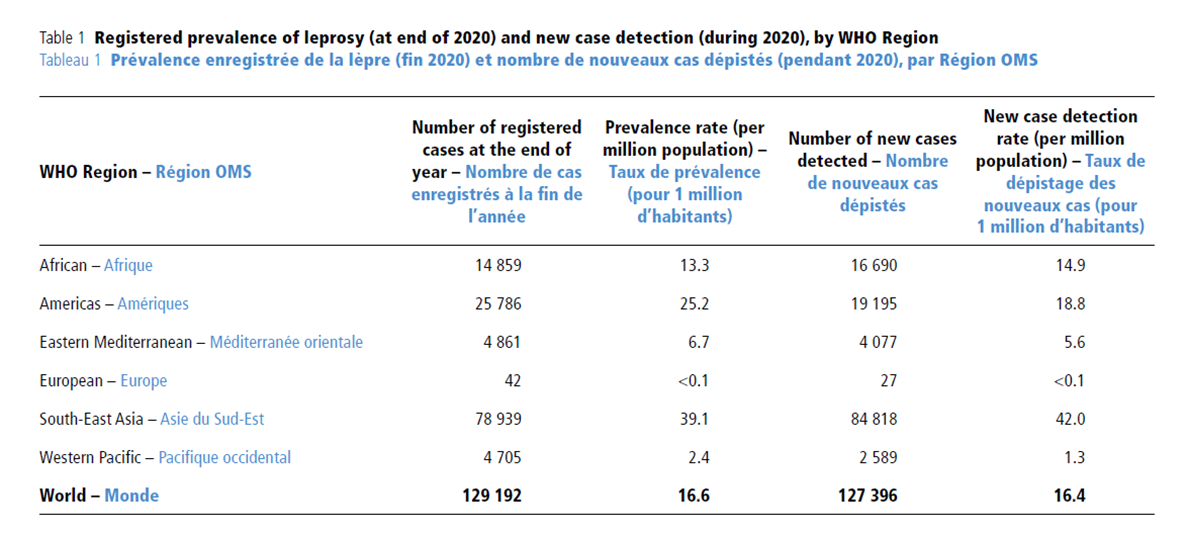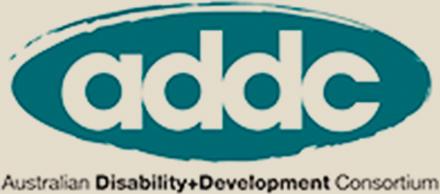Frequently Asked Questions
about leprosy and more
Q: Does leprosy still exist? How many people in the world still have leprosy?
A: Leprosy still exists. In fact, every two minutes, one person in the world is diagnosed. Some countries claim leprosy has been “eliminated” but this just means the number of cases reported and recorded by their government is under 1 case per every 10,000 people (0.01%). Elimination is not eradication.
There are millions of people across the world still living with the effects of leprosy, however, there are only two kinds of leprosy patients currently officially reported:
Registered Cases: patients officially registered to be currently undertaking Multi-Drug Therapy (MDT)
Newly Detected Cases: people newly diagnosed with leprosy in that year
Around 200,000 people across the world are diagnosed with leprosy each year.
Every two minutes one person is diagnosed with leprosy.
According to the latest statistics released by The Word Health Organisation (WHO) in 2020:

Please note: COVID-19 has impacted diagnosis and case finding in the last few years and therefore, there may be many undiagnosed and unreported cases. Hence the numbers reported in 2020 may not be an accurate reflection of the actual prevalence of leprosy.
In Australia & in the countries TLMA supports:

For further information please click here
Further info: This information relies on cases being reported and recorded accurately. There is evidence to suggest in India, for example, that there are “millions” of cases “missing” from the official statistics because these people have not been found or treated or recorded.
Q: Is leprosy contagious? How do you catch leprosy?
A: Yes. Leprosy is mildly contagious. But within 24 -48 hours of starting Multi-Drug Therapy (MDT) the patient is no longer infectious and cannot pass the disease on to others. (*There is no need to quarantine.)
There is no reason to quarantine or distance any person affected by leprosy.
It is thought that leprosy is caught through close direct and prolonged contact with a person infected with leprosy. Most likely through the water droplets of the nose, eyes, and mouth (via coughing and sneezing).
We are still investigating…
Further info: That’s why The Leprosy Mission is investing in and conducting research – so we can stop this disease at the cause and make leprosy a thing of the past.
Who is at risk of developing leprosy?
People of all ages, races, genders, and socio-economic levels can be diagnosed with leprosy. However, most people have an immune system that is strong enough to fight off the bacteria. Weakened immune systems can be caused by poor nutrition, sanitation, and hygiene, as well as by illness and genetics.
Leprosy is primarily present across Asia, South America, and Africa.
For further information please click here
Leprosy is a disease that develops very slowly. It can be many years after a person is infected that they first begin to show symptoms.
Most people who develop leprosy have been in long-term contact with an infectious person, which means they live with or near them, or perhaps work with them.
It is also possible to be exposed to leprosy through animals and through dirt.
Further info: The Leprosy Mission often also conducts “contract tracing” activities to find the patient’s family members, friends, colleagues who may have been exposed to leprosy, testing them for leprosy and possibly providing then with an anti-leprosy medication (rifampicin) which may help prevent infection.
*Since the COVID-19 pandemic, we have grown used to the idea that people must quarantine when they are sick. This is not necessary with leprosy. We have not recommended quarantine for many decades (since the 1950s) because we can diagnose and treat people, so they can stay living with their family without risk to their family or neighbours.
Q: Do you preach and try and convert people with leprosy and disability?
A: The Leprosy Mission is a faith-based organisation, whose work and actions are underpinned by a biblical basis. As such, we seek to live out our Christian beliefs through our compassion and care; seeking to offer health, healing, and spiritual wholeness to people with leprosy and disability irrespective of race, culture, gender, age, language, religion, political or other opinion, national or social origin, birth, or other status. While some Christian activities like pastoral care and counselling are provided as an integral part of being a faith based organisation, we agree to the guidelines set by the Australian government’s department for international development (DFAT — Department of Foreign Affairs and Trade) that their funds are not to be used for activities designed to convert people from one religious faith or denomination to another, or from one political persuasion to another and are not to be used to build up church, ecclesiastical or political structure.
Q: How much does Multi-Drug Therapy (MDT), the CURE for leprosy, cost? Isn’t MDT supplied FREE by The World Health Organisation (WHO) and a big drug company?
A: Yes, Multi-Drug Therapy is supplied to diagnosed patients at no cost to them.
Since 2000, pharmaceutical company Novartis has been providing MDT free of charge to all leprosy patients through the World Health Organisation (WHO).
However, the challenge lies in getting this medicine to the people who need it and ensuring they are cured by completing their full course without interruption, default, or abandonment. (Sometimes distribution system of medication within the country also breaks down due to disruptions such as COVID-19.) This is particularly problematic for patients living in remote or difficult to access areas.
That’s where we help. In the countries in which we work, The Leprosy Mission partners with Government Health Departments and local NGOs to actively find new cases, trace patient contacts, and administer drugs on their behalf. Patients are counselled and supported to help ensure they take their daily dose for the full term (usually 12 months).
Further info: An additional hurdle for low-income or poverty-affected families/communities is that these medications should not be taken on an empty stomach or swallowed with contaminated water. (Vomiting or diarrhea may dispel the medicine before absorption rendering the dose ineffective). However, when a person has leprosy and/or a related physical disability they may be less likely to be able earn an income due to their illness/disability and they may not be able to afford or harvest food for themselves or obtain fresh clean water. Therefore, TLM, and their in-country partners, may also supply nutritional supplementation and/or water filters to patients to bolster the success of their treatment.
Since 2000, pharmaceutical company Novartis has been providing MDT free of charge to all leprosy patients through the World Health Organisation (WHO) (donating more than 56 million MDT blister packs valued at over USD$ 90 million, helping to treat over 6 million leprosy patients worldwide).
Q: Can my donation go to a specific country or a specific object eg. medicine?
A: YES! Your gift can be specifically directed to a country where the community decides the best action to take to help particular people there.
However, regarding specific objects, your gift would go directly towards a project where these items are required as part of the delivery of the program. (Funds are remitted to cover the project budget in which specific items are outlined.)
Q: Can my donation go to a specific person (project participant) mentioned?
(in the story/letter/appeal/catalogue/magazine article/blog/social post etc)
A: The person mentioned is already receiving appropriate treatment, thanks to supporters like you. Your donation will help another person like them.
Q: How much money is spent on administration?
A: Administration FY2021 was 9.5%. We are constantly updating our processes and procedures to be more efficient. We always aim to spend less than 10% on administration.
In the Annual Report, as per ACFID reporting format. Commercial activities and other expenditure (23%) for commercial activities relating to the shop i.e., cost of goods to sell etc.
Q: How much of my donation goes to the field?
A: Our aim is to provide 70 cents in the dollar to support our project work. We are constantly updating processes and procedures to be more efficient.
Further info: Administrative costs include your International Projects team (based in in Melbourne, VIC) who play a vital role in co-ordinating the projects with our partners overseas, as well as working with the Australian Government (DFAT) and peak bodies to ensure The Leprosy Mission Australia complies with government rules and regulations.
Q: How much of my shopping is going towards helping people affected by leprosy?
A: Just by purchasing through The Leprosy Mission Gift Catalogue you are already helping people affected by leprosy as proceeds of the sale of all the items of goods in the catalogue (once cost of goods and expenses have been paid for) go towards funding Leprosy Mission overseas projects.
As well as this, some products have been directly produced by people affected by leprosy therefore the cost of the goods has also been paid to these suppliers.
Further info: Last financial year (FY2021), we purchased $245,555.27 worth of handmade products that help artisans.
- $36,000 purchased from organisations that work with leprosy and disabilities
- $6,000 purchased are linked directly to TLMA projects.
By purchasing a Safe Water Saves Lives product the proceeds of your purchase go directly to safe water (WASH – Water, Sanitation and Hygiene) projects in the countries The Leprosy Mission Australia supports.
Buying a Gift of Love, or a general donation is the most cost-effective way of supporting people affected by leprosy through the gift catalogue.
Q: How much of my Gift of Love goes to the cause and how much to administration?
A: When you buy a Gift of Love through The Leprosy Mission Australia, 70% of the purchase price is allocated towards the project this item is a part of and 30% is to support administrative costs.
Further info: Administrative costs include your International Projects team (based in in Melbourne, VIC) who play a vital role in co-ordinating the projects with our partners overseas, as well as working with the Australian Government (DFAT) and peak bodies to ensure The Leprosy Mission Australia complies with government rules and regulations.
Q: What is the Gift Card that comes with the Gifts of Love?
A: When you buy a Gift of Love through The Leprosy Mission Australia, you will receive a gift card for the item donated. You can keep it as a memento or pass on to someone else to show that you have given it on their behalf.
You can also choose to purchase your Gifts of Love online as a “Print your own card” OR as an ‘e-card’ directly emailed to your recipient. You can also choose not to receive the card if you wish (‘No card sent’ option).
The cards do not mention the price of your gift.
Q: How much does your CEO earn?
A: While I do not know the specific amount, for FY2022, the CEO remuneration was included in note 16 on page 31 of the organisation’s statutory accounts.
Our audited Financial Statements can be accessed here: Annual Reports (see bottom of page for link to current full Financial Statements)
Further info: If they would like to discuss with CEO or Financial Manager, try making an appointment for the following day (if convenient for both parties)
Q: I can’t give the exact amount I’ve been asked for. How is this calculated? Can I give less?
A: Amounts are calculated specific to each appeal and can be used as a guide or suggestion. Of course, we’re extremely grateful for any amount you are moved to give. Every dollar counts.
(Donations $2 and over are tax deductible.)
Q: Can I send into your office physical medical items for TLMA to send/take overseas?
A: To keep administration costs down we do not accept any physical medical items but resource and empower people with leprosy and disability through funding our local partners in the countries where they live. The Leprosy Mission Australia Head Office does not have the resources to facilitate the collection or forwarding of such items overseas.
Q: Can I donate stamps?
A: Not directly anymore. The Leprosy Mission Australia Head Office no longer has the resources to accept and process stamps. However, if your local group or church or yourselves are still collecting, AND organising, the sale of stamps in your state, please continue to do so and donate the proceeds of the sale to The Leprosy Mission Australia. Thank you.
The donated funds from all your activities are very much appreciated by the people affected by leprosy we help.
If you still wish to forward on your used stamps the following organisations do collect them but please note proceeds from sending your stamps to these organisations will not go to The Leprosy Mission Australia:
- Mary MacKillop Today: Reply Paid 88663, North Sydney NSW 2059
- The Lions Club of the City of Adelaide: PO Box 139, Walkerville SA 5081
- Baptist Mission Australia: PO Box 3085, Auburn VIC 3123
Q: Can I send in bandages (or other knitted goods)?
A: Not for the time being, please.
Regarding The Leprosy Mission Papua New Guinea, Country Leader Natalie Smith thanks supporters that they are now in a position where they have over a year’s supply of the very handy knitted cotton bandages. Natalie thanks everyone for their generosity, but as they cannot store any more at this time, she asks to please hold off from knitting and sending anything until further notice. The GOOD NEWS is, The Leprosy Mission Papua New Guinea are finding and treating cases of leprosy early BEFORE ulcers and disability result, so there is less of a need for bandages over all these days. Praise God!
Regarding sending bandages and other woolen knitted items to other countries, if you are personally visiting Anandaban Hospital in Nepal you may be able to take woolen knitted bandages, hats, and scarves in your luggage to donate in person. (Please check prior to your departure that is still the case.)
The Leprosy Mission Australia can no longer recommend supporters send bandages or woolen knitted goods overseas to Nepal (or beyond) at their own cost.There are now many rules, regulations and fees involved to send and receive handmade goods, especially to hospital facilities. Knitted bandages are now cheap and cost effective for many of our partners and hospitals to buy in country.
Further info: Parcels supporters have sent in the past were often expensive, delayed, stolen, or returned which defeated the kind efforts of our generous supporters.
If you would like to be kept up to date on what is happening in PNG, please sign up for Natalie Smith’s Newsletter via email or hard copy
If you would like to speak with our Engagement Officer on the many other ways you can raise funds for people affected by leprosy please email: engage@leprosymission.org.au or FRECALL 1800 537 767
Q: Does leprosy still exist? How many people in the world still have leprosy?
A: Leprosy still exists. In fact, every two minutes, one person in the world is diagnosed. Some countries claim leprosy has been “eliminated” but this just means the number of cases reported and recorded by their government is under 1 case per every 10,000 people (0.01%). Elimination is not eradication.
There are millions of people across the world still living with the effects of leprosy, however, there are only two kinds of leprosy patients currently officially reported:
Registered Cases: patients officially registered to be currently undertaking Multi-Drug Therapy (MDT)
Newly Detected Cases: people newly diagnosed with leprosy in that year
Around 200,000 people across the world are diagnosed with leprosy each year.
Every two minutes one person is diagnosed with leprosy.
According to the latest statistics released by The Word Health Organisation (WHO) in 2020:

Please note: COVID-19 has impacted diagnosis and case finding in the last few years and therefore, there may be many undiagnosed and unreported cases. Hence the numbers reported in 2020 may not be an accurate reflection of the actual prevalence of leprosy.
In Australia & in the countries TLMA supports:

For further information please click here
Further info: This information relies on cases being reported and recorded accurately. There is evidence to suggest in India, for example, that there are “millions” of cases “missing” from the official statistics because these people have not been found or treated or recorded.
Q: Is leprosy contagious? How do you catch leprosy?
A: Yes. Leprosy is mildly contagious. But within 24 -48 hours of starting Multi-Drug Therapy (MDT) the patient is no longer infectious and cannot pass the disease on to others. (*There is no need to quarantine.)
There is no reason to quarantine or distance any person affected by leprosy.
It is thought that leprosy is caught through close direct and prolonged contact with a person infected with leprosy. Most likely through the water droplets of the nose, eyes, and mouth (via coughing and sneezing).
We are still investigating…
Further info: That’s why The Leprosy Mission is investing in and conducting research – so we can stop this disease at the cause and make leprosy a thing of the past.
Who is at risk of developing leprosy?
People of all ages, races, genders, and socio-economic levels can be diagnosed with leprosy. However, most people have an immune system that is strong enough to fight off the bacteria. Weakened immune systems can be caused by poor nutrition, sanitation, and hygiene, as well as by illness and genetics.
Leprosy is primarily present across Asia, South America, and Africa.
For further information please click here
Leprosy is a disease that develops very slowly. It can be many years after a person is infected that they first begin to show symptoms.
Most people who develop leprosy have been in long-term contact with an infectious person, which means they live with or near them, or perhaps work with them.
It is also possible to be exposed to leprosy through animals and through dirt.
Further info: The Leprosy Mission often also conducts “contract tracing” activities to find the patient’s family members, friends, colleagues who may have been exposed to leprosy, testing them for leprosy and possibly providing then with an anti-leprosy medication (rifampicin) which may help prevent infection.
*Since the COVID-19 pandemic, we have grown used to the idea that people must quarantine when they are sick. This is not necessary with leprosy. We have not recommended quarantine for many decades (since the 1950s) because we can diagnose and treat people, so they can stay living with their family without risk to their family or neighbours.
Q: Do you preach and try and convert people with leprosy and disability?
A: The Leprosy Mission is a faith-based organisation, whose work and actions are underpinned by a biblical basis. As such, we seek to live out our Christian beliefs through our compassion and care; seeking to offer health, healing, and spiritual wholeness to people with leprosy and disability irrespective of race, culture, gender, age, language, religion, political or other opinion, national or social origin, birth, or other status. While some Christian activities like pastoral care and counselling are provided as an integral part of being a faith based organisation, we agree to the guidelines set by the Australian government’s department for international development (DFAT — Department of Foreign Affairs and Trade) that their funds are not to be used for activities designed to convert people from one religious faith or denomination to another, or from one political persuasion to another and are not to be used to build up church, ecclesiastical or political structure.




